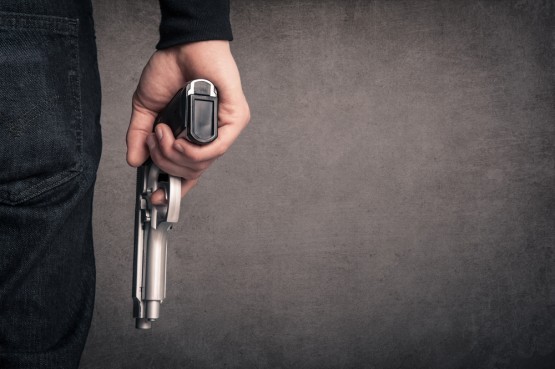A history of violence

WITH awful, numbing regularity Americans use high-powered, high-capacity firearms to carry out mass shootings. And with awful regularity, efforts to reform America’s gun laws in the wake of such tragedies fail. (Indeed, a recent paper published by the Harvard Business School found that a mass shooting leads to a 75% rise in measures easing gun control in states with Republican-controlled legislatures.) More than 30,000 people die in shootings in America each year; no other rich country suffers anywhere near that level of gun violence.
Opponents of gun control argue that such figures have things backwards. In their view, widespread gun ownership deters crime, and thus benefits society. Advocates of tighter restrictions on gun ownership disagree: they believe the spur to gun crime from the ready availability of weapons far outweighs the deterrent effects. Social scientists have long struggled to adjudicate, since, on the surface at least, the data are ambiguous.
Pro-gun groups point out that rates of gun ownership tend to be highest in rural, sparsely populated states, where crime rates are low. By the same token, over the past two decades, as the number of guns in America has risen sharply, crime rates have fallen. Yet even as the number of guns in America has grown, the share of households with a gun has dropped steadily. Research published in 2000 by Mark Duggan of the University of Chicago concluded that the homicide rate had been falling in tandem with the proportion of households where guns were kept. What’s more, the homicide rate was falling with a lag, suggesting that reduced gun ownership was causing the decline, and was not simply a side-effect of a falling crime rate.
Other studies have reached similar conclusions. An analysis published in 2014, for example, using detailed county-level data assembled by the National Research Council, a government-funded body, suggested that laws that allow people to carry weapons are associated with a substantial rise in the incidence of assaults with a firearm. It also found evidence that such laws might also lead to increases in other crimes, like rape and robbery. A recent survey of 130 studies concluded that strict gun-control laws do indeed reduce deaths caused by firearms.
Links between gun ownership and violence are less well established than they might be, in part because lobbyists for gun rights have pushed to reduce public funding for research on the issue. In 2013 the Journal of American Medicine published an article on this phenomenon, describing how in 1996, for instance, Congress ordered the Centres for Disease Control to spend less money contemplating how to reduce shootings.
The main difficulty for academics studying the link between guns and gun crime, however, is the lack of a true counterfactual. A researcher cannot hold all other things constant while varying the stringency of gun laws in order to isolate the effect of those laws on the incidence of violence. That leaves open the possibility that any reductions in crime following a tightening of gun laws may be rooted in other, unrelated causes. Crime rates have tumbled in many rich countries in recent decades, complicating any analysis of the role of guns.
Nonetheless, some events can come close to offering an informative counterfactual. The aftermath of a mass shooting in Australia provides one example. In 1996 a gunman killed 32 people with a semi-automatic weapon much like the one used in the Orlando shooting on June 12th. Australia’s lawmakers quickly passed strict and sweeping gun-control rules. Semi-automatic rifles and pump-action shotguns were banned, and the government offered to buy weapons already in circulation from their owners (a programme of comparable scale in America would reclaim an estimated 90m guns).
Australia has suffered only two shooting sprees since then, claiming a total of seven lives. A decline in the rate of killings with guns, which was already under way before these rules came in, accelerated rapidly. Total gun deaths including suicides also fell. Before the change in the law the rate of deaths from firearms in Australia was about a quarter of that in America; afterwards, it fell to about a tenth of the American rate. In 2014 America suffered about 10.5 fatal shootings per 100,000 people; Australia recorded just 1.
The safety catch
It is not just the relationship between gun ownership and gun violence that is becoming clearer. Evidence is also building that even relatively modest gun-control measures reduce gun deaths. An analysis published in 2015 in the Annual Review of Public Health noted that state laws banning possession of a gun by individuals under a restraining order for domestic violence reduce the incidence of “intimate partner homicide” by 10%. The same analysis reports that firearm homicide rates rose by 25% in the five years after Missouri repealed its law requiring permits to purchase a gun, even as the national rate nationwide fell.
Public-opinion surveys show widespread support for tighter controls on gun-ownership in America. Indeed, nearly half of Republicans, the party most sympathetic to gun ownership, favour a ban on “assault-style” weapons. Their will is frustrated, however, by a political system that enables passionate minorities to stymie legislation.
In 2013, in the wake of the Sandy Hook massacre, in which 20 schoolchildren were shot dead, two senators, one Democrat and one Republican, introduced a measure that would have required background checks on most gun sales. It failed to move forward despite a majority vote in its favour, because supporters were unable to assemble the supermajority needed to overcome a procedural hurdle. Seemingly intractable disputes in American politics do sometimes give way to overdue reform. More probably, America will make scant progress in dealing with its gun problem until it begins to resolve its broader political problem.
Source : www.economist.com
